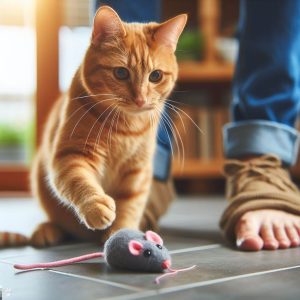Does your cat have tangled clumps of fur that feel like dense cotton balls? These unpleasant knots, called mats, are a common feline woe that perplex cat parents everywhere. Even with regular brushing, mats can still take over your cat’s lush coat. Left unchecked, these matted furballs can cause skin irritation, mobility issues, infections and serious discomfort for kitty.
But what exactly causes fur to knot up into painful mats instead of shedding naturally? The potential culprits range from medical conditions to grooming obstacles to environmental factors. Getting to the root cause of mats is key to preventing and treating them.
In this article, we’ll dig into the top reasons behind knotted cat fur based on veterinary research and pro groomer insights. You’ll learn the most common problem areas for mats on cats, plus safe techniques to detangle minor tangles at home. We’ll also cover when it’s time to seek professional help for removing tightly adhered mats without hurting your cat.
Arm yourself with expert knowledge on how to keep your cat’s coat smooth and mat-free for their health and comfort. Let’s demystify matted cat fur so you can banish painful tangles for good!
What Are Matted Cat Fur and Dreadlocks?
Matted fur occurs when knots and tangles form in a cat’s coat, clumping the hair together. As more loose fur gets trapped in the clump, the mat grows larger and tighter. Matted clumps that are allowed to significantly increase in size are sometimes called “dreadlocks”.
Cat fur becomes matted when the hairs twist around each other instead of falling out when the cat sheds. Matted fur does not necessarily indicate neglect – even well-groomed cats can develop mats. However, a matted coat results from lack of grooming and other factors that prevent the natural shedding process.
Top 7 Causes of Matted Cat Fur
There are several common reasons why cats get matted fur:
1. Inadequate Grooming
Cats spend up to 50% of their waking hours self-grooming. This instinctive behavior helps remove loose hair and distribute natural oils across their coat. When cats do not properly groom themselves, shed fur becomes tangled instead of falling out. Arthritic or obese cats may have difficulty reaching all areas to groom thoroughly.
Tip: Regularly brushing and combing your cat’s coat supplements their self-grooming and decreases matting. Focus extra attention on hard-to-reach areas.
2. Underlying Health Issues
Medical conditions that cause pain, mobility issues, or hormonal imbalances can lead to decreased grooming. Common culprits include:
- Dental disease
- Arthritis
- Obesity
- Hyperthyroidism
- Kidney disease
Cats with these chronic issues tend to self-groom less often, allowing tangles to form.
Tip: Have your vet examine your cat to diagnose and treat any medical problems contributing to matted fur. Managing health conditions can improve grooming habits.
3. Poor Nutrition
A diet deficient in certain nutrients results in a dull, brittle coat. Dry, easily tangled fur is more prone to matting. Essential fatty acids, vitamins, minerals, and complete proteins are vital for skin and coat health.
Tip: Feed a high-quality cat food formulated for your feline’s age and activity level. Wet food provides hydration for better skin elasticity.
4. Dehydration
When cats do not get enough water, their skin becomes dry and less flexible. Inflexible skin traps shed hairs instead of allowing them to release.
Tip: Encourage increased water intake by providing multiple fresh water bowls. Consider adding more moisture to your cat’s diet with wet food or broth.
5. Lack of Brushing
Regular brushing pulls out loose undercoat before it has a chance to tangle. Without this grooming assistance, shed fur remains in the coat and knots develop more easily. Longhaired cats are especially prone to matting without frequent brushing.
Tip: Set a routine for brushing your cat, such as 10-15 minutes daily. Use a stainless steel comb for detangling. Work slowly and gently to avoid pulling painful mats. Reward cooperation with treats.
6. Excess Shedding
Shedding is a normal, healthy process as cats replace old fur with new growth. However, certain factors can cause excessive shedding beyond what daily grooming can handle:
- Changing seasons – more shedding in spring and fall
- Stress, poor health, or nutritional deficiencies
- Pregnancy and lactation
- Normal aging process
The large amount of loose hair overwhelms the cat’s self-grooming efforts, quickly leading to matted fur.
Tip: Help manage heavy shedding with frequent brushing. Give an Omega-3 fatty acid supplement to improve skin and coat health. Reduce stress with pheromone diffusers.
7. Declawing
Declawing removes the claws necessary for cats to grab and pull out loose fur while grooming. It inhibits their natural shedding process. With inadequate grooming and no claw traction, shed hair quickly tangles up.
Tip: Avoid declawing, which often leads to pain and posture issues that decrease grooming abilities. There are humane alternatives for discouraging clawing, such as soft caps and scratching posts.
Where Do Mats Form on Cats?
Matted fur can develop anywhere on a cat’s body, but certain areas tend to collect tangles more easily:
- Belly – Harder for cats to reach and groom
- Back – Difficult to lick thoroughly
- Base of ears – Ears get in the way of grooming
- Armpits – No abrasive licking
- Legs – Thicker fur prone to tangling
- Hindquarters – Tough for cats to twist and reach
- Tail – Prone to matting if long-furred
Pay extra attention when brushing and combing these trouble spots to keep fur well-maintained. Also check for any tender, swollen areas that may indicate an invisible mat.
Dangers and Health Risks of Severely Matted Cat Fur
If left unaddressed, mats and knots progressively worsen and pose serious dangers to a cat’s well-being:
- Skin damage – Tight mats pull and tear skin as the cat moves. Open wounds are prone to infections.
- Pain and discomfort – Matting causes constant pulling and irritation that can make cats withdrawn.
- Inability to properly regulate body temperature – Matted coats do not insulate well, causing cats to get overheated or chilled.
- Parasite infestation – Tangles trap fleas, ticks and dirt close to the skin, causing skin irritation and infections. Mats provide ideal breeding ground for parasites.
- Increased matting – Existing mats snag and trap loose fur, snowballing the problem.
- Restricted mobility – Large mats limit a cat’s flexibility and activity. Severe cases can prevent standing, walking, jumping and bathroom use.
- ** Digestive issues** – Some cats ingest large amounts of fur while overgrooming severely matted areas. Consuming this much fur can lead to dangerous hairballs obstructing the digestive tract.
Catching and combing out minor tangles early prevents them from causing these extreme issues down the road. But severely matted cats require professional grooming for humane, safe de-matting.
How to Prevent Matted Cat Fur Through Grooming
With diligent grooming care, you can minimize knots and tangles from forming in your cat’s coat:
- Brush thoroughly – Use a stainless steel comb to brush all areas of the coat daily, especially thick and hard to reach spots. Work slowly to avoid pain. Give treats and praise as reward.
- Bathe regularly – Bathe your cat every 4-6 weeks to loosen dirt and facilitate brushing out dead hair from the undercoat. Use cat shampoo only. Follow with thorough comb-out while coat is still damp. Air dry fully.
- Clip nails – Blunt nails make grooming less painful. Clip every 2-3 weeks. Introduce gently with treats to build positive association.
- Remove small mats promptly – Comb in cornstarch or detangling spray and gently work apart newly forming knots using fingers or comb. If mats tighten, see a professional groomer promptly.
- Check for parasites – Part fur and look for signs of fleas and ticks, treating promptly to decrease skin irritation and overgrooming.
- Increase hydration – Well-hydrated skin and fur tangles less. Provide fresh water always. Consider wet food.
- Improve nutrition – An unhealthy coat mats more easily. Feed high quality diet with Omega-3s for optimal skin and fur.
- Reduce shedding – Supplements, baths and frequent brushing help control heavy shedding periods like spring and fall.
- Identify medical issues – Manage health conditions so your cat feels more comfortable grooming thoroughly. Treat pain, arthritis, dental disease, etc.
With vigilant grooming care and prompt attention when tangles start, you can keep your cat’s coat soft, knot-free and healthy.
How to Remove Mats from a Cat’s Fur Safely
For minor tangles caught early, there are methods to remove mats at home. But severe matting often requires professional grooming for safe, humane removal.
Removing Smaller Mats at Home
For new, smaller knots in the fur:
- Spray detangling solution or cornstarch onto the mat to lubricate the hair. Avoid getting near eyes, ears, nose and mouth.
- Use your fingers or a flea comb to gently tease apart and loosen the knot. Do not pull or break hair.
- Hold mat at base near skin and use slicker brush tobrush outwards through the tangle.
- Work slowly, stopping if your cat seems distressed. Praise and reward for cooperation.
- Cutting should be an absolute last resort for stubborn knots as it risks nicking the skin. Only trim off a small mat using sharp, pointed tip scissors.
Avoid forcing out a mat that does not brush out relatively easily, as you risk pain, injury and increased matting. Seek professional grooming for mats that you cannot remove within 10-15 minutes of gentle work.
Professional Grooming for Severe Matting
For severe cases with large, tightly-woven mats:
- Do not try home removal – Attempting to rip out tightly adhered mats will cause extreme pain and distress for your cat. Leave it to the professionals.
- Sedation may be required – To fully shave down dense, extensive coat matting without pain, sedation may be administered. This allows the groomer to work safely.
- Shaving is generally needed – Thick pancake-like mats must usually be shaved off rather than tediously picked apart. The matted undercoat gets clipped down to the skin.
- Risks include nicks, clipper burn – With so much neglected coat to remove, accidental nicks or irritation from close shaving can occur. But this is still safer than ripping out masses of tangled fur.
- Emotional impact – Losing their coat can be stressful and confusing for cats. Offer extra comfort and affection. Limit temperature extremes.
- Weekly grooming follows – After shaving, cats require frequent bathing and combing to maintain the regrowing coat and prevent rapid re-matting as hairs re-emerge.
De-matting should never cause a cat undue pain or distress. Trust certified professional groomers to humanely remove severe tangles without trauma.
When to See the Vet for Matted Fur Issues
Consult your veterinarian promptly if:
- You find swellings, lesions, or hot spots under matted fur, indicating skin infection or trauma
- Mats are rapidly worsening despite your grooming efforts
- Your cat seems in pain, distressed or abnormally inactive
- Mats limit mobility or bathroom functions
- Your cat stops grooming or eating due to discomfort
- DIY de-matting is not making progress after 10-15 minutes of gentle efforts
- You cannot maintain weekly grooming care at home after professional de-matting
The vet can assess for medical issues contributing to matting, provide safe sedation if needed for de-matting, prescribe medication for secondary skin infections, and advise ongoing care recommendations customized to your cat. Addressing mats early before they cause skin damage or other problems is ideal.
How to Care for Cats After Removing Severe Matts
Once your cat’s coat has been shaved down due to severe matting, special aftercare helps ensure their health and comfort:
- Prevent temperature extremes – A shaved coat provides little warmth or sun protection. Keep indoor temperatures comfortable and limit direct sun exposure.
- Apply cat-safe moisturizing products – Hydrating sprays, vitamin supplements and conditioning creams help soothe and heal irritated skin after coat removal.
- Provide soft bedding – Choose easily washable beds and blankets. Newly shorn skin is sensitive to dirt, oils and dander.
- Bathe and comb frequently – Bathe at least weekly as new hairs regrow. Gently comb to lift shedding fur and prevent re-matting.
- Give digestible skin supplements – Powders and oils provide nutrients for faster, healthier fur regrowth.
- Use cat clothing if needed – If your cat will tolerate a snug t-shirt, it can provide warmth and protect sensitive skin until the fur coat returns.
- Limit stress – An altered appearance and loss of insulation can distress cats. Offer extra affection and schedule relaxing grooming sessions.
With diligent home care following professional de-matting, your cat’s coat should regrow in 4-6 weeks with proper nutrition and reduced stress. Be vigilant about tangle prevention as the new fur emerges.
Frequently Asked Questions About Matted Cat Fur
How can I detangle small mats at home?
- Spray detangling solution and massage it into the mat to lubricate the hairs
- Use your fingers to gently loosen and unravel the knot
- Starting at skin level, use a comb in short strokes working outwards to tease apart tangles
- Remove shed hairs caught in the mat
- Never pull on matted fur or attempt home removal of large, tightly adhered mats
When should I take my cat to the groomer for de-matting?
You should seek professional grooming assistance if:
- Mats are larger than a quarter or tightly adhered to the skin
- Daily brushing fails to prevent new mats from forming
- Your cat is in obvious pain or distress from matting
- Movement is being restricted
- You cannot gently remove tangles after 10-15 minutes of work
How often should I brush my cat to prevent matting?
- Short-haired cats – Brush once or twice a week
- Long-haired cats – Daily brushing is ideal, at minimum every 2-3 days
- Senior cats – Check and brush daily as grooming habits decline
- During shedding season – Daily brushing when heaviest shedding occurs
Why does my cat get mats even when I brush regularly?
Excessive matting despite frequent brushing may indicate:
- An underlying medical issue causing skin sensitivity or overgrooming
- A skin condition or parasite problem needs treatment
- Diet is lacking nutrients for coat health
- Brushing technique needs more focus on trouble spots
- Higher grooming maintenance is needed for that coat type
See your vet to identify and address factors contributing to excessive tangles.
How long after shaving will my cat’s fur grow back?
On average, expect a shaved coat to regrow completely in 4-6 weeks. Keep your cat’s skin conditioned and nourished to aid healthy regrowth. Boost diet with oils and vitamin supplement. Maintain weekly grooming to prevent matting as hairs regrow.
Conclusion
Matted cat coats result from a variety of factors that interfere with natural shedding and healthy grooming habits. While mild tangles can be remedied with attentive home grooming, severe matting requires professional treatment for safe, humane de-matting and hair regrowth. Stop knots and tangles in their tracks with vigilant brushing care, attention to medical issues, and prompt de-matting assistance when needed. With some diligence, you can maintain your cat’s coat in a healthy, tangle-free condition for optimal comfort and wellbeing.



